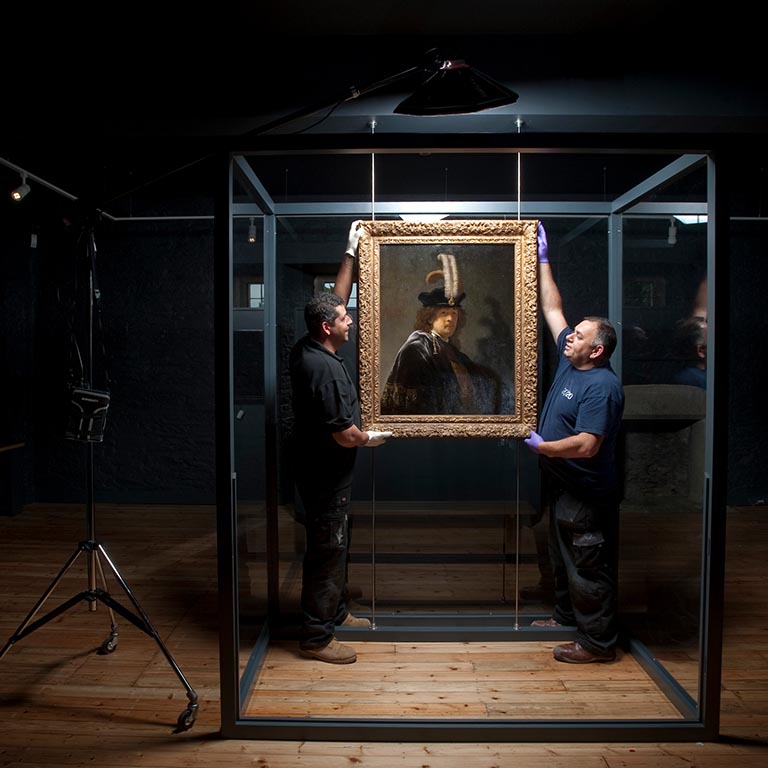Exhibitions and Historic Houses: Reflections on the ‘Why Exhibitions?’ Conference by Peter Moore

Rembrandt self-portrait, being installed for The National Trust’s 2014 exhibition at Buckland Abbey. Image from: https://bit.ly/2uAc6Za
‘Exhibition’ seems to be a rather slippery term these days. In the context of national museums and galleries it might conjure thoughts of huge blockbuster shows, often bringing together an impressive array of loans from across the globe. If I told you I was going to an ‘exhibition’ in London, this is probably the kind of encounter you would think I was describing. A ‘display’, however, might suggest a smaller assemblage of artefacts, perhaps drawn from an institution’s own permanent collection. In other contexts (not exclusively beyond the metropolis, but typically so) it seems the term can be used to describe a whole manner of things, ranging from large scale shows with hundreds of works, to a single small room with just two or three paintings. In the heritage sector the varied application of the term can be even more confusing. Many ‘exhibitions’ at historic houses may arguably be better described as interpretation installations, functioning as a preamble to the place that is about to be encountered. These are often far more permanent fixtures than the word ‘exhibition’ might imply when used in a museum or gallery context. In recent years, however, some curators in the heritage sector have begun to think more creatively about what an ‘exhibition’ might be, or could be. Artist interventions, for example, have been effectively implemented at some historic houses, operating as fragmented temporary exhibitions, punctuating permanent spaces. As a Curator of a country house where exhibitions are not currently a mainstay of the visitor offer, but arguably have the potential to be, these were some of the thoughts in my mind as I strolled down Charing Cross Road towards the National Portrait Gallery for the Why Exhibitions? conference.
Edmund De Waal’s 2012 work all and more, on display in the Dining Room at Waddesdon Manor. © Paul Barker/The National Trust
For a London-based conference it was refreshing to hear from so many regional curators – a welcome reminder that innovation is alive and well in the profession right across the UK. As George Vasey recently suggested, regionalism is as much an idea as a location. Far from being a pejorative term, the Why Exhibitions? conference showed that in the field of curating in twenty-first century Britain, regionalism seems to be increasingly aligned with experimentation, creativity and risk taking. Yet, as Ellen McAdam argued in the first presentation of the day, regional museums do have a different relationship with their audiences, and a different function – especially in terms of exhibitions. Small budgets do not always extend very far beyond paying for core functions, and it is often hard to justify putting on a temporary exhibition that will only run for a couple of months. This is certainly true from my experience, but for the exhibition-minded curator it can paradoxically act as a catalyst for resourceful ways of working, and promote new ways of thinking about one’s own collection.
Anne Stewart and Hannah Crowdy discussing their participation in the National Gallery’s ‘Masterpiece Tour’ initiative in 2016. © Anna Liesching, Twitter

Rembrandt self-portrait, being installed for The National Trust’s 2014 exhibition at Buckland Abbey. Image from: https://bit.ly/2uAc6Za
The approach of the Ulster Museum in Belfast provided food for thought, particularly their treatment of Rembrant’s Self-Portrait at the age of 63, borrowed as part of the National Gallery’s ‘Masterpiece Tour’ in 2016. As Anne Stewart and Hannah Crowdy explained, the intention was to create a feeling of intimacy by encouraging visitors to engage with one work in relative isolation. This called to my mind the National Trust’s 2014 exhibition at Buckland Abbey, in which a newly attributed Rembrandt self-portrait was similarly allowed to take centre stage. At my main place of work, Audley End House and Gardens, there is certainly no shortage of old master paintings, and for many visitors there is perhaps a case of not seeing the wood for the trees. All too often, exquisite works of art in country houses simply become part of the furniture. Subtly repositioning individual items, emphasising them through careful alterations to lighting, or making small modifications to their immediate surroundings, can make all the difference to how they are experienced or interpreted. In the absence of dedicated exhibition galleries, these kinds of interventions are crucial for the country house Curator wishing to offer something new. Conversely, the discussion of the ‘Masterpiece Tour’ also caused me to reflect on the potential of loaning one’s own collection for such projects. It is often the case that historic houses close to the public over the winter months; perhaps we should be making more of this period as an opportunity to loan works to external partners, and foster new collaborations in exhibition making.
A new online exhibition for Wrest park combines factual and interpretive content with the opportunity for users to roam the house and gardens: https://artsandculture.google.com/exhibit/KgJiV0ZCiGDgKA
Effectively providing information about collections, and interpreting them for visitors, is one of the key challenges of my role as a country house Curator. In most instances, labels on walls are not an option in historic interiors. The trusty guidebook or picture list still serves a purpose, but I’m sure we could be more innovative on this front in the heritage sector. Digital may well be the answer. English Heritage have in the past year successfully collaborated with Google Arts and Culture, creating online ‘exhibitions’ about some of the organisation’s best loved sites, and many of its lesser known ones too. In the penultimate presentation of the conference, Cathy Waters and Ruth Brimacombe discussed their use of digital technology to curate an exhibition online when it was not possible to do so physically. One of the benefits, they suggested, was being able to show zoomable images in high resolution. Far from replacing the experience of viewing a work of art with a new form of armchair tourism, it seems to me that online exhibitions might function as important shop windows for cultural institutions, ultimately generating more visits. If this encourages closer looking at individual artworks then it’s certainly something I’m keen to explore further.
Benjamin West’s 1772 portrait of Sir John Griffin Griffin, 4th Lord Howard de Walden on display in the South Library at Audley End. English Heritage’s commissioning of fully-zoomable gigapixel photography allows a closer viewing experience: https://artsandculture.google.com/asset/portrait-of-sir-john-griffin-griffin/ogHyHIefu7cF-Q Image from Historic England Photo Library

